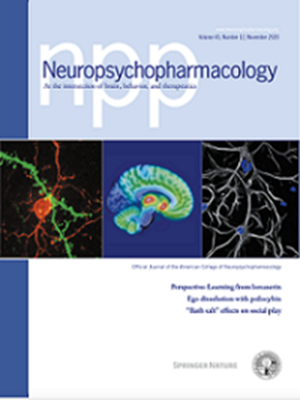N-acetylcysteine for youth cannabis use disorder: randomized controlled trial main findings
IF 6.6
1区 医学
Q1 NEUROSCIENCES
引用次数: 0
Abstract
Cannabis use disorder is particularly prevalent and impairing among young people, and evidence-based treatments are limited. Prior trials of N-acetylcysteine, added to contingency management as a platform behavioral intervention, yielded positive findings in youth but not in adults. This trial sought to rigorously evaluate whether N-acetylcysteine is efficacious in youth when not paired with a robust behavioral treatment platform. Treatment-seeking youth with cannabis use disorder (N = 192, ages 14–21) were randomized to receive a double-blind 12-week course of oral N-acetylcysteine 1200 mg or placebo twice daily; all received weekly medical management and brief behavioral counseling. The primary efficacy outcome was the proportion of negative urine cannabinoid tests during treatment, compared between groups. An array of self-report and urine testing measures were examined secondarily to assess cannabis use reduction and cessation outcomes. The N-acetylcysteine and placebo groups did not differ in proportion of negative urine cannabinoid tests (RR = 0.93, 95% CI = 0.53, 1.64; p = 0.80) or self-reported cannabis abstinence (RR = 1.02, 95% CI = 0.63, 1.65; p = 0.93) during treatment. The mean percentage of cannabis use days and grams of cannabis used per using day decreased over time during treatment but did not differ between groups. More N-acetylcysteine than placebo treated participants reported gastrointestinal adverse events (63/98 versus 37/94, χ21 = 11.9 p < 0.001); adverse events were otherwise similar between groups. Findings indicate that N-acetylcysteine is not efficacious for youth cannabis use disorder when not paired with contingency management, highlighting the potentially crucial role of a robust behavioral treatment platform in facilitating prior positive efficacy findings with N-acetylcysteine. Trial Registration: Clinicaltrials.gov identifier NCT03055377

n -乙酰半胱氨酸治疗青少年大麻使用障碍:随机对照试验的主要发现。
大麻使用障碍在年轻人中特别普遍和有害,循证治疗有限。先前的试验将n -乙酰半胱氨酸添加到应急管理中,作为行为干预的平台,在青少年中产生了积极的结果,但在成人中没有。该试验旨在严格评估n -乙酰半胱氨酸在没有与强大的行为治疗平台配对时是否有效。寻求大麻使用障碍治疗的青少年(N = 192,年龄14-21岁)随机接受双盲治疗,为期12周,每日两次口服N-乙酰半胱氨酸1200毫克或安慰剂;所有人都接受了每周的医疗管理和简短的行为咨询。主要疗效指标是治疗期间尿大麻素试验阴性的比例,比较两组之间的差异。其次检查了一系列自我报告和尿液检测措施,以评估减少大麻使用和戒烟的结果。n -乙酰半胱氨酸组和安慰剂组尿大麻素检测阴性的比例无差异(RR = 0.93, 95% CI = 0.53, 1.64;p = 0.80)或自我报告的大麻戒断(RR = 1.02, 95% CI = 0.63, 1.65;P = 0.93)。在治疗期间,大麻使用天数的平均百分比和每天使用的大麻克数随着时间的推移而减少,但组间没有差异。n -乙酰半胱氨酸治疗的参与者报告的胃肠道不良事件多于安慰剂治疗的参与者(63/98比37/94,χ21 = 11.9 p
本文章由计算机程序翻译,如有差异,请以英文原文为准。
求助全文
约1分钟内获得全文
求助全文
来源期刊

Neuropsychopharmacology
医学-精神病学
CiteScore
15.00
自引率
2.60%
发文量
240
审稿时长
2 months
期刊介绍:
Neuropsychopharmacology is a reputable international scientific journal that serves as the official publication of the American College of Neuropsychopharmacology (ACNP). The journal's primary focus is on research that enhances our knowledge of the brain and behavior, with a particular emphasis on the molecular, cellular, physiological, and psychological aspects of substances that affect the central nervous system (CNS). It also aims to identify new molecular targets for the development of future drugs.
The journal prioritizes original research reports, but it also welcomes mini-reviews and perspectives, which are often solicited by the editorial office. These types of articles provide valuable insights and syntheses of current research trends and future directions in the field of neuroscience and pharmacology.
 求助内容:
求助内容: 应助结果提醒方式:
应助结果提醒方式:


